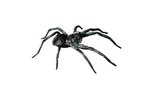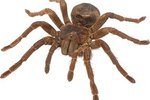When the light catches them perched on their webs just right, spotted western orb weavers are one of the more beautiful spiders in North America. Although they're not normally aggressive, they can bite. There's no reason to worry, though -- they're not poisonous to humans.
Spotted Western Orb Weaver Overview
The spotted western orb weaver (Neoscona oaxacensis) lives in the southwestern United States. As its name suggests, it spins webs and has spots, although you have to get pretty close to see them in some cases. Although many spiders display gross sexual dimorphism -- that is, females look a lot different than males -- the main difference between male and female spotted western orb weavers is a slight matter of size and coloring. Females are 11 to 17 millimeters, about double the size of males. Both share color palettes -- brown, yellow, white, purple and red -- but females are brighter and have stronger contrasts.
Colorful, Not Dangerous
Although their bite can sting, there's no reason to worry about spider bites from these guys. They're not poisonous. Technically speaking, they're venomous -- poison involves ingestion or absorption, venom involves injection -- but their venom isn't strong enough to seriously injure, let alone kill, a healthy human. They're not, for instance, included on the University of Nebraska-Lincoln's list of "Spiders of Medical Importance," which even includes the largely harmless parson spider. One list, from the pest website Termite.com, includes "orb-weaving spiders" at large, but lists them as a low-risk, non-aggressive species. Still, all spiders can and will bite if provoked. Spotted western orb weavers can be quite beautiful, but use care when observing them.
Spider Bites
All spiders have venom. Very few, though, have potent enough venom to be a danger to humans. And, contrary to popular belief, they don't usually bite people while they're sleeping. More than 80 percent of suspected spider bites are actually caused by other arachnids or insects, according to the University of Minnesota. True spider bites have two puncture marks, although the wound isn't always obvious. The bite of most spiders, including spotted western orb weavers, usually results in minor reddening, swelling, itching and pain. Black widow and brown recluse spiders are the two obvious exceptions -- their bites can require medical attention -- although death is off the table for most healthy adults.
Look-Alikes
Spider identification can be a tricky business, especially when it comes to spiders in the same genus. The namesake markings on a spotted western orb weaver are vital to its identification, in part because its habitat occasionally overlaps with two similar-looking species: Neoscona crucifera and Neoscona domiciliorum. Spider spotting is like fingerprints -- it's a unique identifier for which no two are the same. Sometimes an orb weaver's spots are subtle, but they'll always be there. Both the look-alike species tend to live in wetter climates than their spotted brethren and are often duller in color, but it's easy to get confused. Other members of the Neoscona genus, particularly N. arabesca, share similar traits. Regardless, all such species pose scant danger to humans. It may be better to leave esoteric taxonomic issues to the etymologists.
References
- BugGuide.net: Species Neoscona oaxacensis -- Western Spotted Orbweaver
- InsectIdentification.org: Western Spotted Orb Weaver (Neoscona oaxacensis)
- University of Florida: Featured Creatures -- Orb Weavers
- University of Minnesota Extension: Potentially Dangerous Spiders
- Iowa State University Extension and Outreach: Are Spiders Poisonous?
- Termite.com: USA Spider Identification Chart
Resources
- BugsInTheNews.com: Spotted Orbweaver Female (Neoscona Oaxacensis)
- Natural History of Orange County, California: Western Spotted Orbweaver
- Bug Eric: Western Spotted Orbweaver
- Florida Nature: Neoscona Domicilorum
- SpiderzRule.com: Spider Photos -- Orbweaver (2013)
- University of Nebraska-Loncoln: Spiders of Medical Importance




